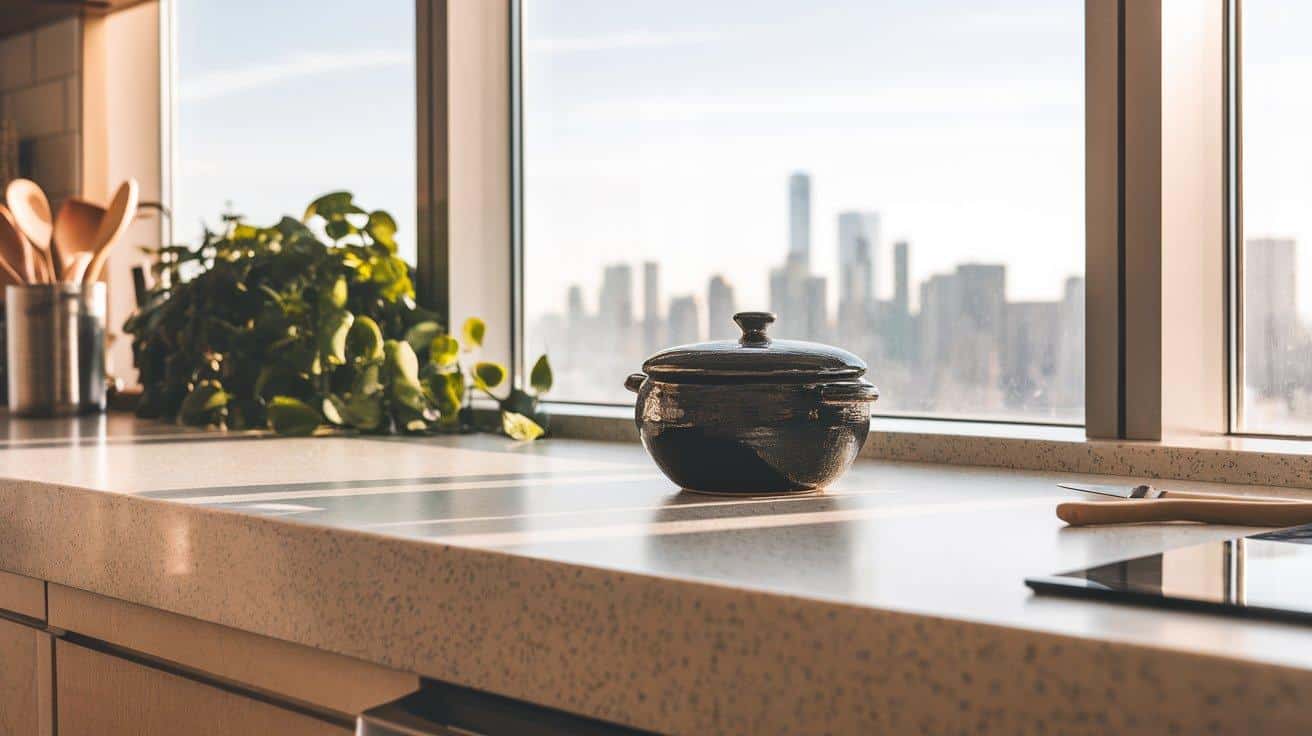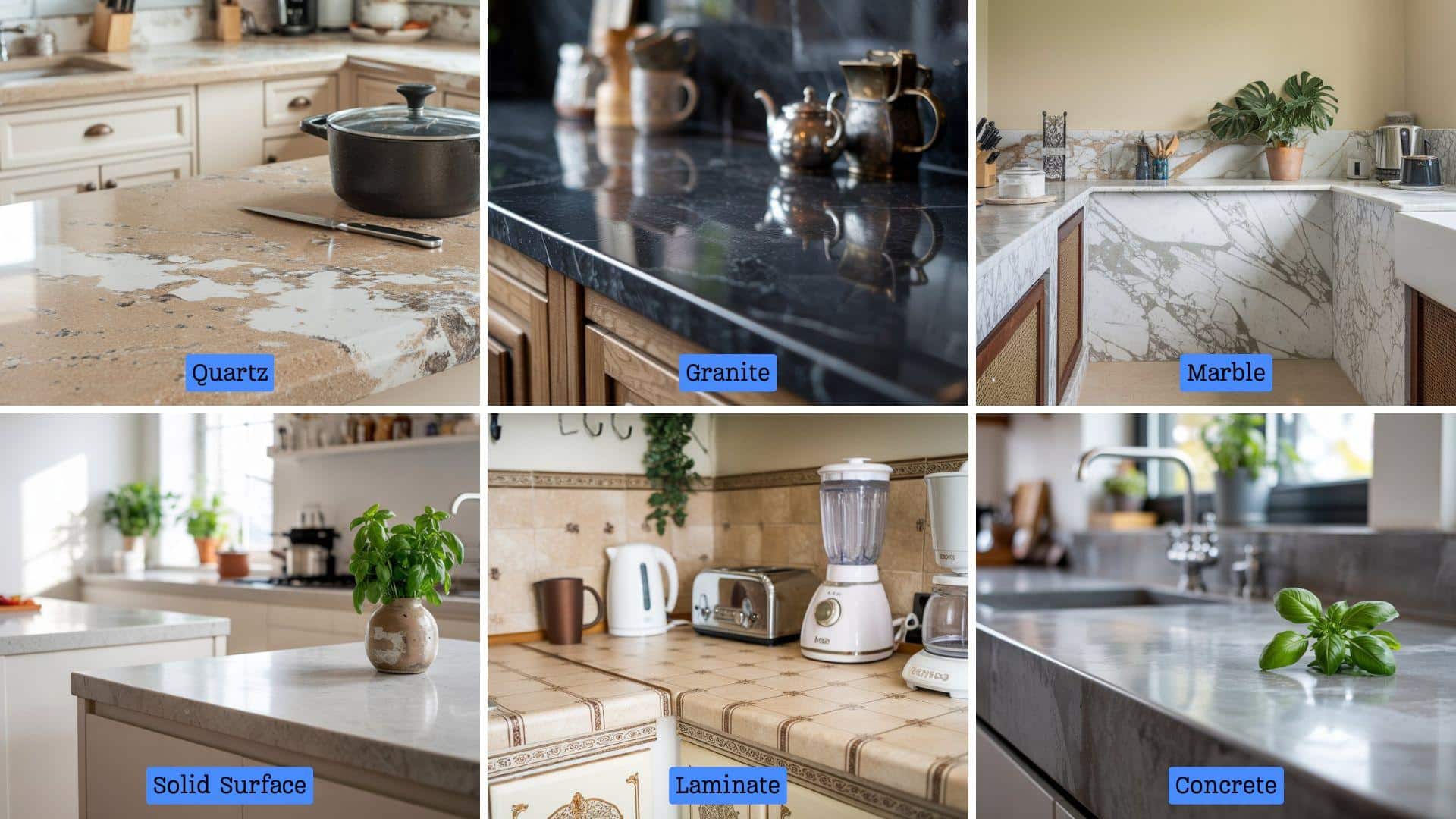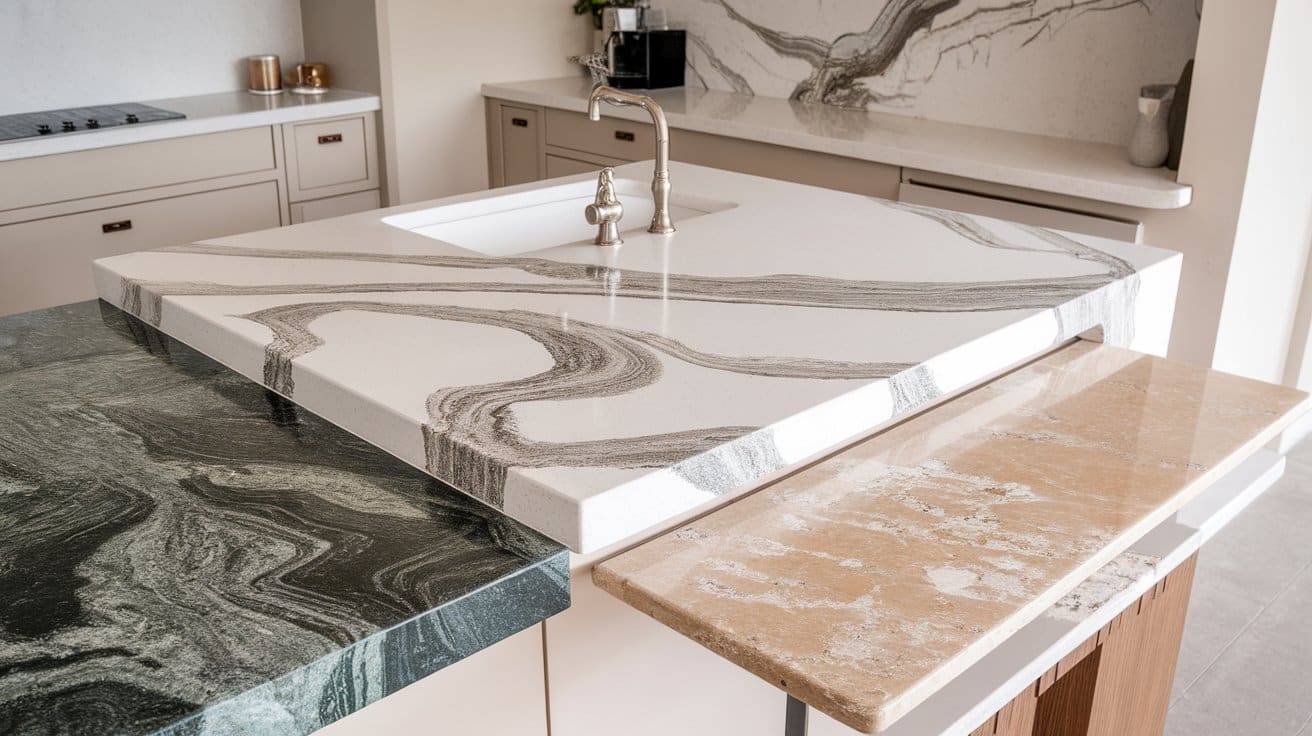Have you ever wondered what makes quartz countertops so popular in modern kitchens? These surfaces have become a top choice for homeowners seeking both beauty and function.
Quartz countertops combine natural stone with advanced engineering. This blend creates surfaces that resist stains, scratches, and heat better than many alternatives.
Understanding the materials helps you make informed decisions for your home. The exact blend of components determines durability, appearance, and maintenance requirements.
Most homeowners want to know what they’re investing in before making such an important purchase.
I’ll walk you through every component that goes into these engineered surfaces. You’ll learn exactly what makes quartz countertops so durable and appealing for use in the kitchen.
What Are Quartz Countertops Made Of?
Quartz countertops contain approximately 90-95% ground natural quartz crystals. Manufacturers crush the mineral into various sizes, from fine powder to larger chips.
The remaining 5-10% consists of polymer resins and pigments. These binding agents hold the quartz particles together and add color options.
Main Components:
- Natural quartz crystals (90-95%) – Provides hardness and durability
- Polymer resins (4-7%) – Acts as a binding agent
- Pigments and dyes (1-3%) – Creates color variations
- Metallic flecks (optional) – Adds visual depth and sparkle
The exact ratios vary between manufacturers and product lines. Premium brands often use higher quartz content for superior performance.
Some manufacturers add recycled glass or metallic particles for unique appearances. These additions still maintain the core quartz-resin foundation that defines engineered stone.
Why Is Quartz Chosen for Countertops?

Quartz offers superior hardness compared to natural stone options, such as marble or granite. This strength prevents chips and cracks from occurring due to daily kitchen activities.
The non-porous surface resists bacteria and stains without requiring regular sealing. Unlike natural stone, engineered quartz maintains its protective barrier permanently.
Consistent patterns and colors appeal to modern design preferences. Manufacturers control the appearance, eliminating the natural variations found in quarried stone.
Low maintenance requirements attract busy homeowners. Simple cleaning with soap and water keeps quartz surfaces looking new for years.
How Resins and Binders Shape Quartz Countertops?
Polymer resins serve as the glue that binds quartz particles into solid slabs. These synthetic materials cure under heat and pressure to create permanent bonds. The resin system determines how well the final product performs in kitchen environments.
Types of Resins Used:
- Epoxy resins – Provide the strongest adhesion between quartz crystals and cure to form cross-linked polymer chains that won’t break down over time
- Polyester resins – Offer cost-effective binding for lower-grade products, but may not provide the same long-term durability as epoxy systems
- Specialized additives – UV stabilizers prevent color fading, while antimicrobial agents resist bacterial growth.
Impact on Final Properties:
- The resin content directly affects the product’s characteristics; higher percentages create more flexible slabs but reduce overall hardness.
- Curing temperatures reach 180°F during manufacturing to activate chemical reactions that permanently lock quartz and resin together.
- Bond strength determines resistance to cracking, chipping, and separation under stress.
Pros vs Cons of Quartz Countertops
Quartz countertops offer significant advantages but come with some limitations worth considering.
| Pros | Cons |
|---|---|
| Non-porous surface – Resists stains and bacteria | Heat sensitivity – Can discolor from hot pans |
| Consistent appearance – Uniform patterns and colors | Limited repair options – Damage requires professional fixes |
| Low maintenance – No sealing required | Higher cost – More expensive than laminate or tile |
| Scratch resistance – Harder than most kitchen materials | Weight concerns – Requires strong cabinet support |
| Stain resistance – Won’t absorb liquids or oils | Visible seams – Joints may show in large installations |
|
Variety of styles – Many colors and patterns available |
Not heat-proof – Extreme heat can cause permanent damage |
The benefits typically outweigh the drawbacks for most kitchen applications. Understanding both sides helps you make the right choice for your needs.
Now that we’ve covered the basic components of quartz, let’s take a look at how these materials are transformed into the beautiful and durable countertops you see in modern kitchens.
Manufacturing Process of Quartz Countertops
The production of quartz countertops follows a precise multi-step process that ensures consistent quality and performance.
Step 1: Raw Material Preparation Workers extract quartz from quarries and crush it into specific size grades. The crushed material gets sorted into different particle sizes, ranging from fine powder to larger chips.
Step 2: Blending and Mixing Computer-controlled systems combine quartz particles with liquid resins and pigments. This step ensures consistent ratios throughout each batch for uniform quality.
Step 3: Molding and Pressing The mixture gets shaped into a slab form using massive presses. These machines apply 100 tons of pressure while vibrating to eliminate air bubbles.
Step 4: Curing and Hardening Slabs move into specialized ovens where temperatures reach 180°F for several hours. This heat fully cures the resin binders and creates permanent bonds.
Step 5: Cooling and Calibration Finished slabs cool to room temperature gradually to prevent thermal stress. This controlled cooling prevents cracking or warping in the final product.
Step 6: Surface Finishing Multiple grades of abrasives grind and polish the surface to create the final texture and shine. Quality inspectors check each slab before packaging.
Step 7: Packaging and Shipping Special crates protect the finished surfaces during transport to fabricators and retailers.
Quartz Countertops vs. Other Countertop Materials

Understanding how quartz compares to alternatives helps guide your material selection.
| Material | Composition | Maintenance | Durability | Cost Range |
|---|---|---|---|---|
| Quartz | 90-95% quartz + resins | Very low | Excellent | $50-$90/sq ft |
| Granite | 100% natural stone | High (requires sealing) | Very good | $40-$80/sq ft |
| Marble | 100% natural stone | Very high | Fair | $50-$100/sq ft |
| Solid Surface | Acrylic/polyester blend | Low | Good | $35-$70/sq ft |
| Laminate | Paper/resin layers | Low | Fair | $10-$30/sq ft |
| Concrete | Cement/sand/aggregates | High | Good | $30-$60/sq ft |
Quartz sits in the premium category but offers superior performance for the investment. The combination of beauty and functionality justifies the cost for many homeowners.
Natural stone alternatives require more ongoing care, while synthetic options may lack the prestige of engineered quartz.
Impact and Sustainability of Quartz Countertops
Environmental considerations play an important role in material selection for eco-conscious homeowners.
Key Environmental Factors:
- Long lifespan reduces replacement frequency and minimizes waste over time.
- Energy-intensive manufacturing requires significant electricity during production processes.
- Mining operations impact local ecosystems where quartz extraction takes place.
- Non-biodegradable resins don’t break down naturally in landfills.
- Recycled content used by some manufacturers includes waste glass and manufacturing scraps.
- Transportation emissions increase due to heavy slab weights during shipping.
Conclusion
Quartz countertops blend natural minerals with modern engineering to create superior kitchen surfaces. The combination of 90-95% crushed quartz with polymer resins produces materials that outperform many alternatives.
Understanding the composition helps explain why these surfaces resist stains, scratches, and daily wear so effectively. The investment in quartz countertops pays off through reduced maintenance and long-term durability.
Your kitchen deserves surfaces that combine beauty with function. Quartz countertops deliver both qualities while requiring minimal ongoing care from busy homeowners.
What questions do you have about the composition of quartz countertops? Share your thoughts in the comments below, or let us know what factors matter most in your material selection process.
Frequently Asked Questions
Is Quartz Better than Granite?
Both materials have unique benefits. Quartz offers low maintenance and stain resistance, while granite provides natural patterns and superior heat tolerance. Your choice depends on personal preferences and kitchen needs.
Does Quartz Need to Be Sealed?
No sealing required for quartz countertops. The non-porous surface naturally resists stains and bacteria without additional treatments, unlike natural stone materials that absorb liquids and need regular sealing.








